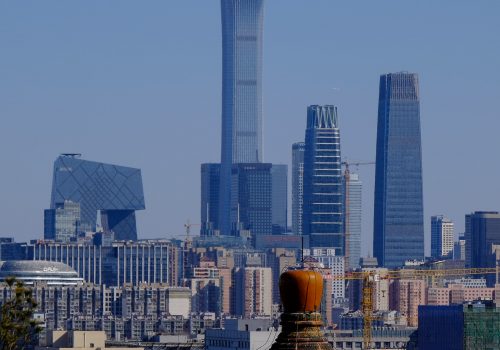Trading geopolitics: The US-Chinese capital markets
This piece follows up on a previous article by the author on the Chinese capital markets.
What are US lawmakers trying to achieve by discussing whether or not some 150 Chinese companies listed on US exchanges should be delisted? Is their goal US-Chinese financial decoupling? While discussions about Chinese listings in the US are technically about accounting rules, they should be understood in the broader geopolitical context.
One of the key questions for the future world order is how Western capital markets will be connected to Chinese capital markets. The level of integration between the Chinese and Western capital markets affects China’s economic growth. The greater the links, the better Chinese growth prospects.
If China continues to gain increased access to Western capital China may soon be in a better economic position to challenge the Western liberal capitalist model. However, increased Chinese-Western capital market integration is just one scenario, dependent upon many political and geopolitical factors. Instead of the increased integration we’re witnessing now, ”strong decoupling” or “muddling through” may prove more likely, depending upon the changing perceptions of China and the Chinese financial markets in the US and the West.
For several decades, key Wall Street institutions successfully worked towards US-Chinese financial integration and opening China’s markets. The January 2020 US-China Phase One Deal was a highlight for American banks, which gained the ability to become controlling owners of Chinese financial institutions. US private equity and venture capital has long been actively investing in China. Notwithstanding recent lockdowns and geopolitical uncertainty, Western banks continue to expand their presence in China.
Crucially, since 2016, there has been a significant increase in US and European investors in China’s public markets for stocks, bonds, and derivatives. This flow of Western institutional investment capital into China took off after stock and bond index providers like MSCI, FTSE Russell, and Bloomberg-Barclays decided to include mainland Chinese assets in their indices. Their decision lead to the inflow of hundreds of billions of additional dollars from the US and Europe into Chinese stocks and bonds. In the summer of 2021, Western holdings of Chinese financial assets reportedly amounted to 1.1 trillion US dollars. In early July 2022, Chinese authorities announced “swap connect,” allowing international investors to access China’s €3.1 trillion swaps market.
However, geopolitical tensions, or “strategic competition” between Washington and Beijing may well stand in the way of further US-Chinese financial integration. US policy makers increasingly perceive that national security is about economic security, which makes international finance a key part of geopolitical dynamics. Thus, institutional investors, as well as international banking and private equity and venture capital are becoming increasingly tied up in US national security affairs.
This trend was marked by the Trump Administration’s expansion of the Committee on Foreign Investments in the United States (CFIUS) with the Foreign Investment Risk Review Modernization Act or FIRRMA, which significantly limited Chinese investment into the US. Concerned about US businesses assisting China’s military-technological rise, the Biden Administration may soon supplement FIRRMA with new legislation to screen outbound foreign direct investment.
Beyond the private markets, there is an emerging pattern of US-Chinese competition for dominance in global banking and potential conflict in the banking markets. As a further indication of US-Chinese tensions in the banking markets, US banks in China have very recently begun to publicly voice differences of opinion with China’s financial authorities.
Regarding portfolio investment in China, both the Trump and the Biden Administrations issued executive orders to prevent US capital investment in the Chinese military-industrial complex. In the Biden White House’s still cautious language, this “signals that the Administration will not hesitate to prevent US capital from flowing into the People’s Republic of China’s (PRC) defense and related materiel sector, including companies that support the PRC’s military, intelligence, and other security research and development programs; or into Chinese companies that develop or use Chinese surveillance technology to facilitate repression or serious human rights abuse.” Considering the significant overlap between the military, security, and civilian components of the Chinese economy, a wide range of Western portfolio investments in China may ultimately become subject to outflow restrictions.
The debate now is whether, and to what extent, US institutional investors should be barred from holding Chinese financial assets. In the financial industry, there are those strongly in favor of deepening US-Chinese capital market integration. The asset manager Blackrock has called for a further tripling of Western capital flows into China. Similarly, Bridgewater’s Ray Dalio argued that China is on a path forward and highly investable, notwithstanding unavoidable risks. Voices in favor of expanding US-Chinese financial integration seem less concerned with the geopolitical consequences of their investments in China.
On the other hand, several influential voices opine that portfolio investments in China are bad for US national security. In late 2021, the US-Chinese Economic and Security Review Commission (USCC) pointed out that Western portfolio inflows into China’s stock and bond markets undermine US national security in several ways. First, Western money is used to directly fund Chinese military and national security companies. Second, outside investments can flow into Chinese conglomerates which encompass both military and civilian parts. Third, apparently civilian companies still contribute to Chinese military and security technology through China’s military-civil fusion programs, as well as through business ecosystems which facilitate financial and technological know-how, as well as other transfers between civilian and military business. Fourth, Western investments in China’s stock and bond markets make China richer overall and thus allow the CCP to expand its military budget.
It is likely that geopolitical motives will trump business instincts. The overall US relationship with China is dominated by strategic considerations, and finance is increasing seen as an integral part of the equation.
One can only speculate about the consequences as the US moves to further separate American and Chinese capital markets. The structure of international capital markets may become bifurcated, with one centered on China, and one centered on the US dollar. A partial financial decoupling with the effect of trillions being sucked out of, or locked up in, China at once, may cause global contagion and financial instability. How China will react or whether it will seek to deter any US financial decoupling remain relevant questions.
To prevent Western institutional investors from entering the Chinese market, the US will also have to ensure that portfolio investors from Europe will end their exposure to China. This could cause a Transatlantic imbroglio, which will be discussed in a subsequent piece.
As the official US stance on portfolio investments in China is still evolving, international policy makers, market participants, and observers should correspondingly adjust. The most important thing all three groups can do now is to carefully observe the US debate on geopolitical competition with China and be aware that this debate is likely to affect the future of both China’s capital markets and the structure of global finance. Most important of all, this era of financial geopolitics requires that international financial institutions learn to take national security into account at every turn.
Dr. Elmar Hellendoorn is a nonresident senior fellow with the GeoEconomics Center and the Europe Center.

At the intersection of economics, finance, and foreign policy, the GeoEconomics Center is a translation hub with the goal of helping shape a better global economic future.
Image: USA and China flag on coins stacking .It is symbol of economic tariffs trade war and tax barrier between United States of America and China.


